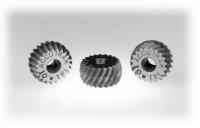Knurling Information
Diametral Pitch Knurling & Conversions
Determining Centerline with Straddle Holders
Approx. Increase in Knurled Diameter
Surface Speed to RPM Conversions
Numbers of Teeth on Stock Knurls
The Problem of Straight Form Knurling in a 2 Die Straddle Holder
Articles:
Convex Knurls Speed Rotor-Shaft Production for Power-System Manufacturer
When to Roll Form, When to Cut
Tips to Upgrade Knurling Practices
Tips to Upgrade Knurling Practices
| CUTTING TOOLS |
| MAGAZINE-IN-MAGAZINE |
| http://www.metlfax.com/ |
 cutting tool
cutting tool
technology focus
Tips to upgrade knurling practices
Most knurling jobs are still performed using form-type dies on turning machines such as lathes and screw machines. Little has changed in die design or the materials most commonly used. Although knurling has been labeled “half science and half art,” there is essentially no substitute for experience. What should amount to a simple, repetitive operation can fast become a frustration when knurling dies double track.
To achieve sound tracking when knurling from the cross slide, it is vital to get good initial die penetration during the first revolution. Thus you should set your machine for low spindle speed with a fast in-feed. These opening adjustments are difficult to accomplish on a CNC or screw machine. When knurling with a CNC machine, some operators will stop the spindle and push the dies into the part before activating the spindle. When generating a diamond knurl pattern with a straddle holder, this “trick” has proven successful.
If you struggle with conventional dies on a job demanding extra wide knurls or have trouble knurling a small diameter part, there is the option of turning to “low force” designed knurls that assure effective penetration at the outset. By removing a portion of the die’s teeth, this adjustment allows for the concentration of higher pressure to the part’s contact area. However, double the number of revolutions is required to roll up the part versus a conventional knurl.
The creation of “convex”-style knurls within the past three years by Accu Trak has given knurl users multiple advantages. Convex series knurls have a tooth form that rolls over the edge, giving the knurl die a barrel-like appearance. Manufactured from high cobalt steel and coated for additional hardness with TiN and other premium coatings, these knurls work best when axial feeding is involved.
In the past, conventional forming dies were simply beveled on the edges to enhance performance. When knurling alloy steels (stainless in particular) with a beveled edge die, “plowing action” results. When compared to the “slicing action” of a convex type knurl, the latter yields a smoother, precise finish. It also results in longer tool life and lower forces exerted on the holder and spindle bearings.
About knurl holders
As with knurls, there are several types of holders to accomplish most jobs. It is a safe practice to insist on carbide pins with a clearance of approximately 0.0005" to 0.0015" for lubrication. When straddle holders are used in axial feeding, pivoting parts need minimal clearance for best results. Since forces required can be high, a rugged holder (usually the largest available) should be selected.
It is not necessary to use a custom holder when knurling on a tapered surface or the face of a part. Stock holders are available to match most of today’s knurling job requirements. However, if the tapered knurl pattern on a part is long, it is best to have a custom die made.

